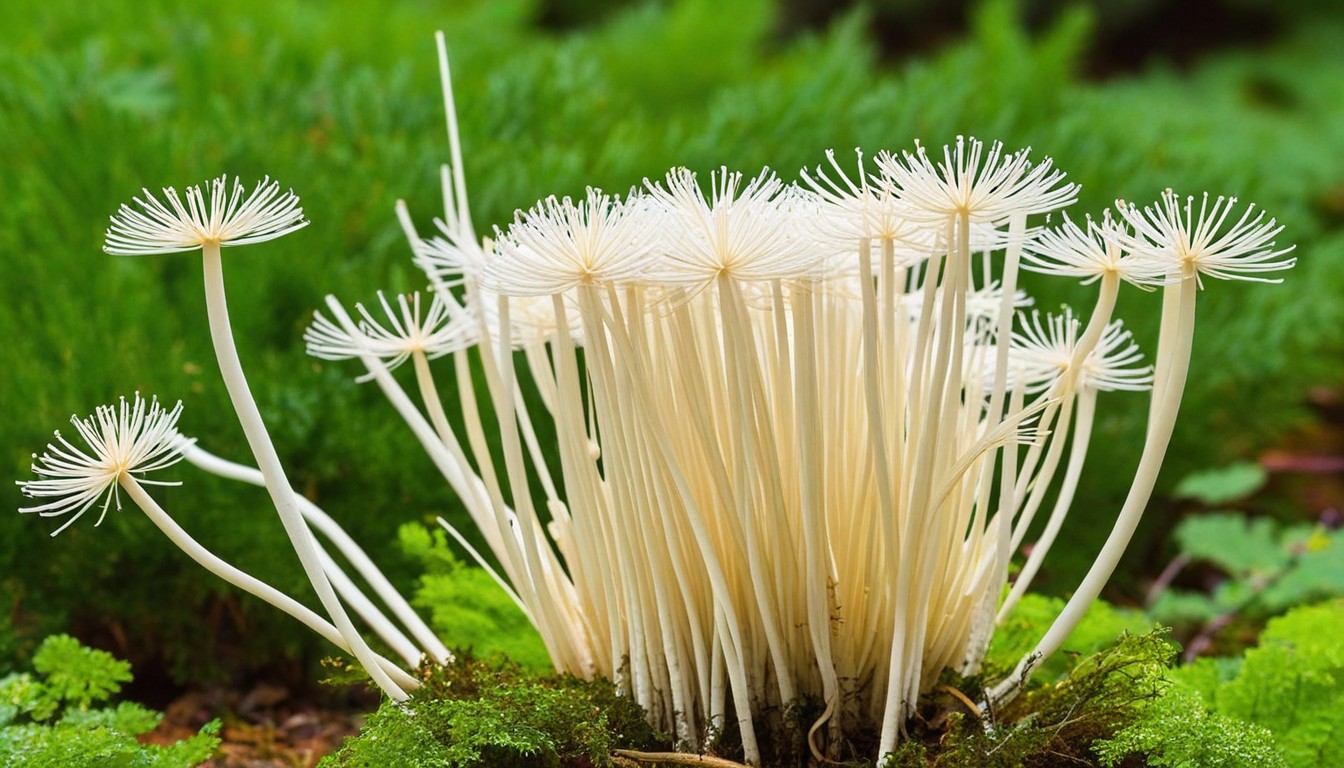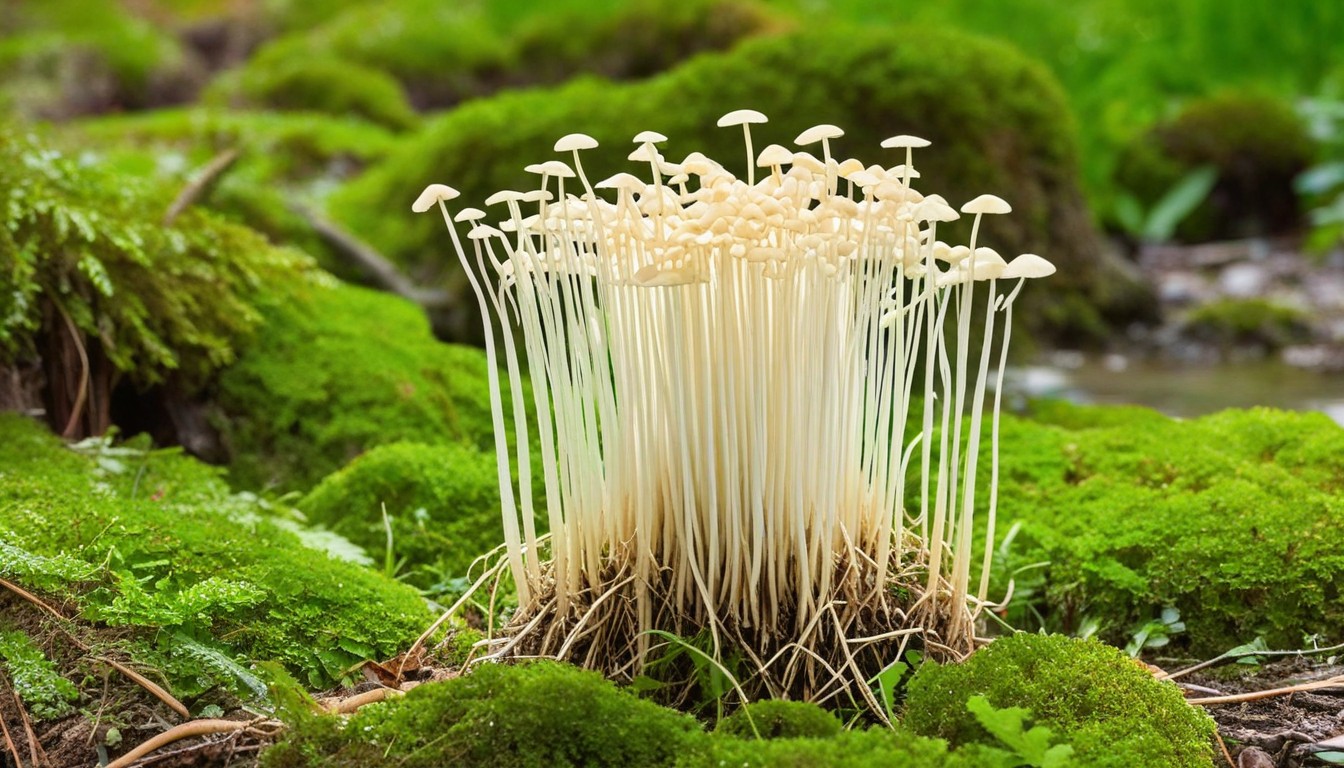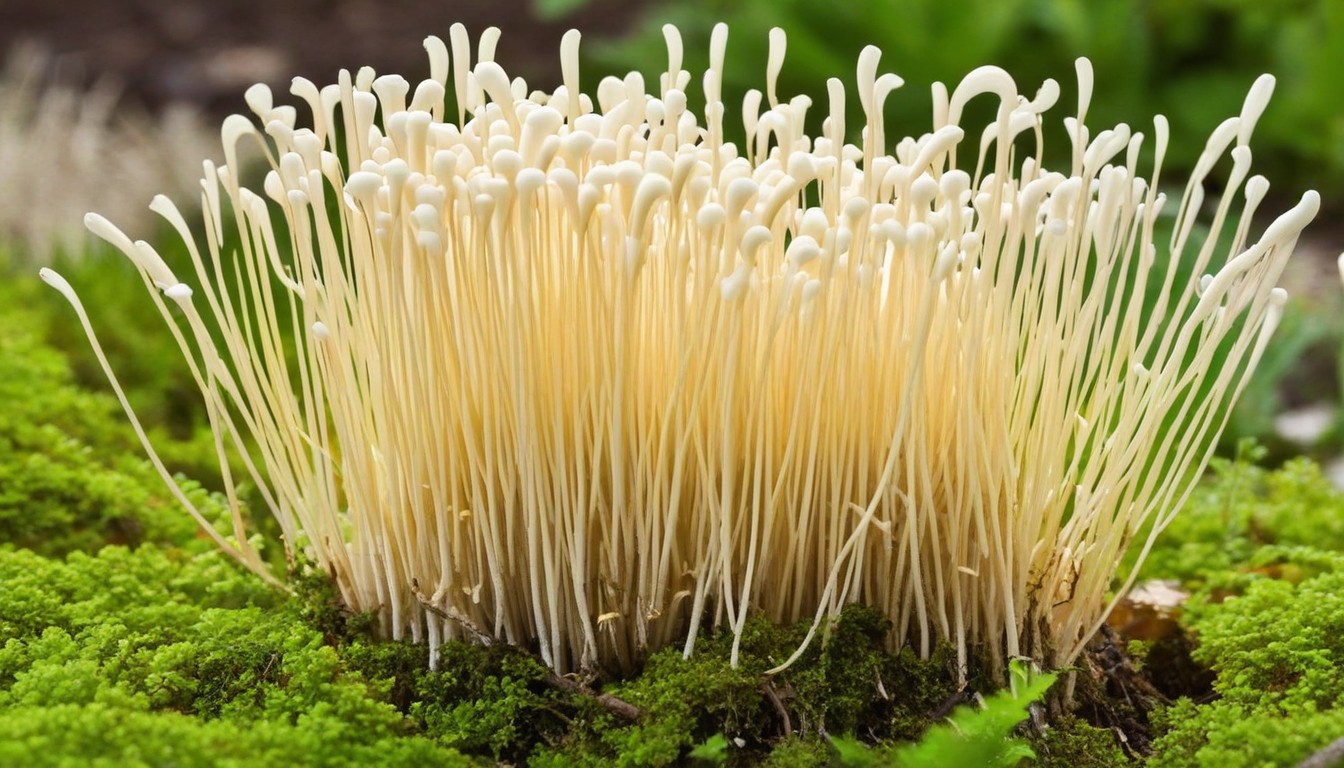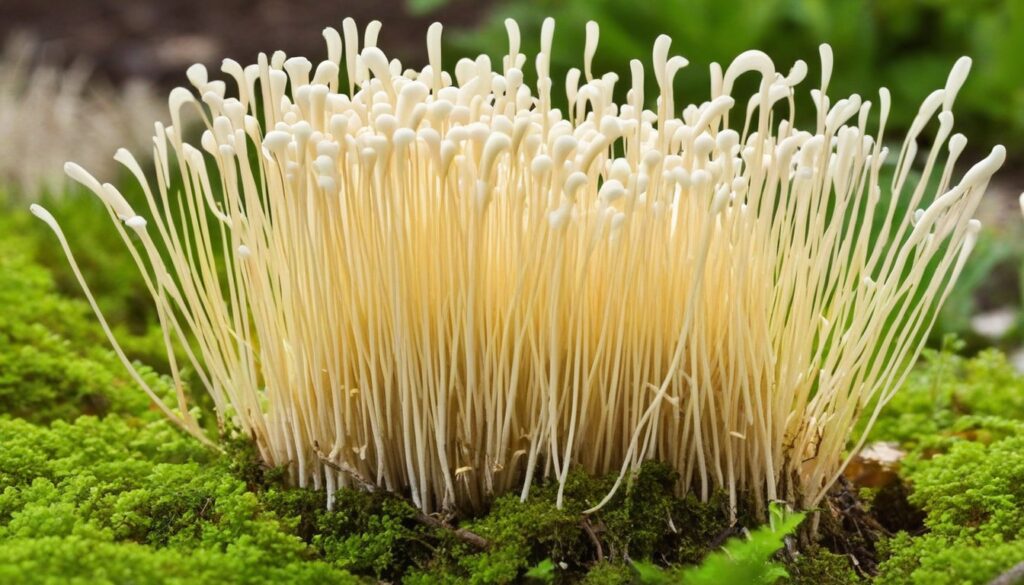If you’re a fan of Enoki mushrooms and want to enjoy them fresh from your own home, then you’re in the right place. Whether you are an experienced grower or just starting, this comprehensive guide will provide you with everything you need to know to cultivate Enoki mushrooms successfully.
Growing Enoki mushrooms can be a rewarding experience, and with the right knowledge and dedication, you can enjoy a bountiful harvest of this delicate and flavorful fungi.
Key Takeaways
- Enoki mushrooms can be successfully grown at home.
- Knowledge and dedication are needed to cultivate Enoki mushrooms.
- This guide provides comprehensive information and guidance on everything you need to know to grow Enoki mushrooms successfully.
- The right growing method, preparation of substrate, maintenance of growing conditions, and disease and pest prevention are key factors to successful cultivation.
- After harvesting your Enoki mushrooms, they can be used in a variety of delicious recipes.
Understanding Enoki Mushrooms
Enoki mushrooms, also known as Enokitake, are a popular mushroom variety commonly used in Asian cuisine. They have a delicate, crunchy texture and a mild, slightly sweet flavor that pairs well with a variety of dishes.
Enokis have slender stems and small, white caps, growing in tight clusters. Unlike most mushrooms, Enokis grow best in cooler temperatures and bright light conditions.
When it comes to nutrition, Enoki mushrooms are a rich source of vitamins B and D, as well as antioxidants and dietary fiber. They are also low in calories, making them an excellent choice for anyone looking to maintain a healthy diet.
Enoki Vs. Other Mushroom Varieties
|
Mushroom Variety |
Appearance |
Taste |
Texture |
|---|---|---|---|
|
Shiitake |
Large, brown cap with white stem |
Meaty, earthy, with a slight smokiness |
Firm and chewy |
|
Portobello |
Large, brown, meaty cap with a short stem |
Meaty, umami flavor |
Dense and chewy |
|
Oyster |
Flattened, oyster-shaped, with a delicate cap |
Mild, slightly sweet, with a subtle earthiness |
Tender and velvety |
|
Enoki |
Slender body and small white caps |
Mildly sweet and delicate |
Crunchy and slightly chewy |
Compared to other mushroom varieties, Enoki mushrooms have a unique taste and texture that make them a favorite among mushroom lovers. Their delicate flavor and crunchy texture make them ideal for salads and soups, while their small size and elegant appearance make them a beautiful garnish for various dishes.
The Enoki mushroom is a culinary treasure in Asian cuisine for its texture and visual appeal.” – Cameron Stauch
Understanding the unique characteristics of Enoki mushrooms is essential to successfully growing them at home. In the following sections, we’ll guide you through the process of selecting the right growing method, preparing your growing space, and much more to ensure a bountiful harvest of these delicate mushrooms.
Choosing the Right Growing Method
When it comes to growing Enoki mushrooms, you have two primary options: growing kits or starting from scratch using a substrate. The method you choose will depend on several factors, such as your experience level and the equipment you have available.
Growing Kits
Growing kits are an excellent option for beginners or those who don’t have much experience cultivating mushrooms. They come equipped with everything you need to start growing Enoki mushrooms, including spawn, substrate, and a container. Simply follow the instructions provided with the kit, and you’ll be on your way to a bountiful harvest in no time.
One of the benefits of using a growing kit is that it’s relatively easy to set up. It’s also a more controlled environment, making it easier to regulate temperature and humidity levels. However, growing kits can be more expensive than starting from scratch, and you may not have as much control over the substrate used.
Starting from Scratch with a Substrate
If you have more experience with mushroom cultivation, starting from scratch with a substrate may be a better option. This method involves creating a substrate from scratch using sawdust, straw, or a combination of both. You’ll also need to source your own spawn and container.
Starting from scratch allows you greater control over the substrate used and the ability to adjust the growing conditions to your liking. However, it does require more experience and effort to get started, and there’s a higher risk of contamination or other issues arising.
Ultimately, the method you choose will depend on your experience level, budget, and personal preference. Consider the pros and cons of each method before making your decision, and don’t be afraid to experiment to find what works best for you.
Preparing Your Growing Space

Before you begin cultivating your Enoki mushrooms, it’s essential to prepare the right growing space to ensure optimal growing conditions and a bountiful harvest.
First, select the ideal containers for your Enoki mushrooms. Unlike other mushroom varieties, Enoki mushrooms grow best in tall containers, such as plastic bottles or bags. You can also create your own growing containers using PVC pipes or wooden frames.
|
Container Type |
Pros |
Cons |
|---|---|---|
|
Plastic Bottles/Bags |
Easy to find and can be recycled |
May not provide enough ventilation |
|
PVC Pipes/Wooden Frames |
Can be customized to fit your growing space |
Require more time and effort to construct |
Next, ensure proper ventilation and lighting for your growing space. Enoki mushrooms require a well-ventilated area to prevent moisture buildup, which can lead to mold growth. Consider adding a fan to your growing space or opening a window to promote airflow.
For lighting, Enoki mushrooms thrive in indirect natural light or low fluorescent light. Avoid exposing them to direct sunlight, as it can dry out the growing substrate and harm the delicate mushrooms.
Finally, maintain the ideal temperature and humidity levels for your growing space. Enoki mushrooms require a cool and humid environment, with temperatures ranging between 45°F to 55°F and humidity levels between 65% to 75%. Consider using a hygrometer to monitor humidity levels and a thermometer to keep track of the temperature.
Sourcing High-Quality Enoki Mushroom Spawn:

Obtaining quality Enoki mushroom spawn is one of the most critical steps for a successful harvest. You can purchase Enoki mushroom spawn online or from a reliable supplier near you.
“Choose a supplier that guarantees fresh, viable, and contaminant-free strains to achieve optimal results.”
There are two types of spawn: grain spawn and sawdust spawn.
The grain spawn is created on a grain substrate, which provides a nutrient-rich environment for the mycelium to grow. It is faster to colonize than sawdust spawn and is ideal for smaller home cultivators.
On the other hand, sawdust spawn is composed of sawdust and grain, providing a nutrient-dense environment for mycelium growth. Sawdust spawn can take longer to mature, but it is less likely to become contaminated than grain spawn.
|
Type of Spawn |
Advantages |
Disadvantages |
|---|---|---|
|
Grain Spawn |
Faster colonization |
High risk of contamination |
|
Sawdust Spawn |
Less prone to contamination |
Longer colonization time |
When sourcing Enoki mushroom spawn, it is crucial to buy from a reputable seller to ensure the quality and viability of the spawn. Be sure to choose a supplier that guarantees fresh, viable, and contaminant-free strains to achieve optimal results.
Once you have obtained your Enoki mushroom spawn, it’s time to move on to the next step- preparing the substrate.
Preparing the Substrate
Enoki mushrooms require a specific substrate to grow, and preparing the substrate is a critical step in ensuring a successful harvest. There are various substrate options available, including sawdust, straw, or a combination of both, each with its advantages and disadvantages.
Sawdust is an excellent option for indoor cultivation because it is readily available, easy to work with, and less prone to contamination. However, it can be more difficult to colonize, and you may need to supplement it with additional nutrients to promote mycelium growth.
|
Substrate |
Pros |
Cons |
|---|---|---|
|
Sawdust |
Readily available, easy to work with, less prone to contamination. |
Difficult to colonize, may need to supplement with nutrients. |
|
Straw |
Rich in nutrients, promotes rapid colonization, affordable. |
Prone to contamination, requires careful preparation. |
|
Combination of Sawdust and Straw |
The best of both worlds, good nutrient content, and ease of colonization. |
Requires precise preparation and careful sterilization, less readily available. |
Straw is another popular substrate option, rich in nutrients and promoting rapid colonization. It is affordable and a sustainable choice, but it needs careful preparation as it is prone to contamination. A combination of sawdust and straw gives you the best of both worlds, having good nutrient content and ease of colonization, but requires precise preparation and careful sterilization.
Once you have decided on your substrate, it’s time to prepare it. If you’re using sawdust, you will need to sterilize it by boiling in water or using an autoclave.
Pro Tip: Use a meat thermometer to ensure the sawdust has reached the optimal temperature (160-180°F) for sterilization.
If you’re using straw, you will need to chop it into smaller pieces, mix it with water, and heat it to pasteurization temperature. Ensure that the substrate is well-drained and slightly damp but not too moist before adding the mushroom spawn.
Now that you have prepared your substrate, it’s time to inoculate it with Enoki mushroom spawn, which we’ll discuss in the next section.
Inoculating the Substrate with Spawn
Now that you have a prepared substrate, it’s time to inoculate it with the Enoki mushroom spawn. This process involves evenly adding the spawn to the substrate and ensuring that it is mixed thoroughly, creating the ideal conditions for the mushrooms to grow.
Begin by selecting a high-quality Enoki mushroom spawn that is free of contaminants. You can purchase spawn online or from a reliable supplier. It’s crucial to handle the spawn carefully during the inoculation process to prevent contamination.
Take the prepared substrate and add the spawn to it, distributing it evenly throughout the substrate. Be sure to mix the substrate thoroughly to ensure that the spawn is evenly distributed. This process can be done by hand or using a specialized mixing tool.
After inoculation, make sure to cover the substrate with a layer of plastic or a lid to keep the moisture level consistent. Allow the substrate to sit for several days while the mycelium spreads throughout the substrate.
During this stage, it’s essential to maintain ideal growing conditions to ensure the spawn takes hold and begins to thrive. Check the temperature and humidity levels regularly, making any necessary adjustments.
Once the mycelium has fully colonized the substrate, you’re ready to move on to the fruiting stage and watch your Enoki mushrooms grow!
Maintaining Ideal Growing Conditions for Enoki Mushrooms

Enoki mushrooms thrive in a specific environment, so it’s crucial to maintain the ideal growing conditions to ensure a successful harvest. Here are some important factors to consider:
Temperature
Enoki mushrooms prefer cooler temperatures between 45°F and 65°F (7°C and 18°C) during the growing stage. To maintain these temperatures, consider using temperature control devices like a thermometer or thermostat.
Humidity
Enoki mushrooms require high humidity levels ranging between 80% and 90%. To maintain ideal humidity levels, consider using a humidifier or misting the growing environment frequently.
Airflow
Good airflow is important to maintain proper gas exchange, which allows the mushrooms to breathe. Consider using a fan to improve air circulation, but be careful not to let the fan directly blow on the mushrooms.
Lighting
Enoki mushroom cultivation requires low levels of light. The mushrooms grow best under indirect lighting conditions, away from direct sunlight. Use a low-wattage bulb or a natural light source, such as a north-facing window.
Monitoring
Monitoring and maintaining the ideal growing conditions throughout the entire process is essential for the success of your Enoki mushroom cultivation. Regularly check the temperature, humidity, airflow, and lighting to ensure they remain consistent.
Pest Prevention
One of the key factors in maintaining ideal growing conditions is keeping pests and disease away. Preventative measures such as sanitizing equipment before use, maintaining a clean growing space, and inspecting the mushrooms regularly, can help you avoid pests and disease.
By following these essential growing conditions, you’ll be on your way to a bountiful harvest of delicious Enoki mushrooms.
Disease and Pest Prevention
Preventing and addressing diseases and pests during the cultivation process is crucial to ensure a successful harvest of your Enoki mushrooms. Here are some tips to prevent common issues:
Pest Prevention

To minimize the risk of pest infestation, it’s essential to keep your growing space clean and well-ventilated. Make sure to dispose of any organic material or contaminated substrate immediately to reduce the risk of pests, such as flies, gnats, or mites. Covering your growing containers with mesh or netting can also provide an extra layer of protection. If you notice any pests in your growing space, remove them manually or use organic pest control methods.
Disease Prevention
One of the most common diseases Enoki mushrooms may face is bacterial wet rot, which can cause the mushrooms to become slimy and discolored. To prevent this, make sure your growing space is well-ventilated, and don’t oversaturate the substrate with water. Another preventive measure is to maintain hygiene throughout the growing process, wearing gloves to handle the substrate and tools. Avoid overcrowding the containers, as this can increase the risk of disease. Use organic fungicides to treat any potential disease if it appears.
“Preventing the development of diseases and pests is always better than curing them. Keeping a watchful eye on your growing environment and following the steps outlined above can provide a robust defense against potential issues.”
Maintaining optimal growing conditions, as outlined in the previous section, can also play a pivotal role in disease and pest prevention. By ensuring the right combination of moisture, temperature, and humidity levels, you’ll be providing the best possible environment for your Enoki mushrooms to thrive.
Harvesting Enoki Mushrooms
Congratulations! Your Enoki mushrooms have finally reached the perfect stage of maturity and are ready to be harvested. Timing is crucial for a delicious and satisfying harvest, as the mushrooms grow quickly and can become overripe in just a few hours, losing their signature delicate flavor and texture.
To ensure optimum quality and flavor, we recommend harvesting your Enoki mushrooms as soon as their caps begin to separate from the stems. This typically occurs about two to three weeks after inoculation, depending on the environmental conditions and the type of substrate used.
When harvesting Enoki mushrooms, it’s crucial to handle them gently to prevent any damage or bruising. Simply grip the base of the stem and twist gently but firmly to pull the mushroom out of the substrate. Avoid cutting the stem as it may cause the remaining mycelium to rot or become contaminated.
You can harvest all the mature mushrooms in one go or pluck them individually as they ripen, depending on your preference. Once harvested, give the mushrooms a quick rinse under cold water to remove any residual substrate or debris, and they’re ready to be consumed immediately or stored for later use.
Storing Enoki Mushrooms
Enoki mushrooms are best enjoyed fresh, but if you have a surplus, they can be stored for several days in the refrigerator. Place them in a paper bag or a loosely covered container to help regulate moisture and prevent the mushrooms from becoming slimy or moldy.
If you plan to store the mushrooms for a longer period, you can blanch or sauté them first, then freeze them in an airtight container. Frozen Enoki mushrooms can be stored for up to six months and are ideal for use in stir-fries, soups, or stews.
Enjoying Your Homegrown Enoki Mushrooms
Now that you’ve successfully harvested your Enoki mushrooms, it’s time to enjoy the fruits of your labor! These delicate and flavorful mushrooms are a delicious addition to many dishes.
One simple way to savor your homegrown Enoki mushrooms is by sautéing them with garlic and butter. Another popular dish is to add them to soups or stews for a unique flavor and texture.
If you’re feeling adventurous, try making Enoki mushroom sushi rolls for a fun and creative twist on traditional sushi. Or incorporate them into your favorite stir-fry or noodle dish for a tasty and healthy meal.
When it comes to storing your Enoki mushrooms, it’s best to keep them in a paper bag in the refrigerator. Avoid washing them until you’re ready to use them, as excess moisture can shorten their lifespan.
With their delicate texture and unique flavor, Enoki mushrooms are a versatile ingredient that can add a new dimension to many dishes. So get creative, experiment with different recipes, and enjoy the delicious taste of your homegrown Enoki mushrooms!
Conclusion
In conclusion, the process of growing Enoki mushrooms at home may seem daunting at first, but with the right guidance and dedication, it can be an incredibly fulfilling and rewarding experience. Not only will you have the satisfaction of growing your own food, but you’ll also get to enjoy the unique flavor and texture of Enoki mushrooms in your culinary creations.
Remember to take the time to understand the unique characteristics of Enoki mushrooms and choose the growing method that suits your needs best. Take care in preparing your growing space and sourcing high-quality spawn and substrate, then ensure you maintain ideal growing conditions throughout the entire process.
While it’s essential to prevent pests and diseases, don’t be discouraged by any challenges that arise during the growing process. With a little patience and perseverance, you’ll soon be harvesting your homegrown Enoki mushrooms and enjoying their delicate flavor in a variety of dishes.
We hope this comprehensive guide has provided you with all the information you need to successfully grow Enoki mushrooms at home. Happy cultivating!
FAQ
Can I grow Enoki mushrooms indoors?
Yes, Enoki mushrooms can be successfully grown indoors. With the right growing conditions and methods, you can cultivate these mushrooms in the comfort of your own home.
How long does it take to grow Enoki mushrooms?
The growing process for Enoki mushrooms typically takes around 2-3 weeks from inoculation to harvest. However, the exact timing may vary depending on factors such as temperature and humidity.
Do Enoki mushrooms require special lighting?
Enoki mushrooms prefer indirect light rather than direct sunlight. You can achieve this by providing them with ambient or artificial light sources, such as fluorescent or LED lights.
Can I use a growing kit to cultivate Enoki mushrooms?
Yes, using a growing kit is a convenient option for growing Enoki mushrooms. These kits usually come with pre-inoculated substrate and detailed instructions, making the cultivation process easier for beginners.
What are the ideal temperature and humidity levels for Enoki mushrooms?
Enoki mushrooms thrive in cooler temperatures ranging from 45 to 55°F (7 to 13°C) and high humidity levels of around 85-95%. Maintaining these conditions is essential for successful cultivation.
Can I grow Enoki mushrooms using coffee grounds?
While coffee grounds can be used as a substrate for some mushroom varieties, Enoki mushrooms require a different type of substrate, such as sawdust or straw. These provide the necessary nutrients and structure for optimal growth.
Are Enoki mushrooms easy to grow for beginners?
Yes, Enoki mushrooms are considered relatively easy to grow, making them a great choice for beginners. With proper care and attention to their specific requirements, you can achieve a successful harvest.
How do I know when Enoki mushrooms are ready to harvest?
Enoki mushrooms are typically harvested when the caps are fully elongated and the stalks are firm. They should still be white in color and tightly attached to the substrate. Harvesting at the right stage ensures optimal flavor and texture.

